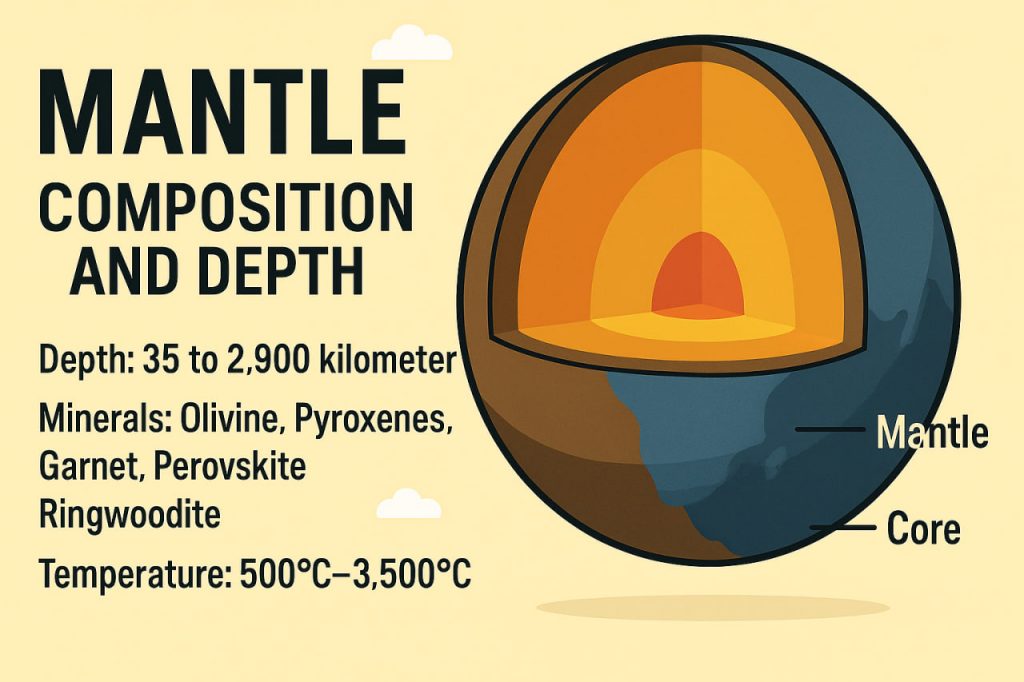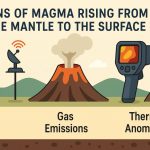The mantle is the thick, rocky layer of Earth located between the crust and the core. It makes up about 84% of Earth’s volume and plays a key role in processes such as plate tectonics, volcanism, and heat transfer. The mantle is not completely solid; it behaves plastically, allowing slow movement of material that drives the motion of continents.
Depth and Structure
The mantle extends from about 35 kilometers beneath continents (and as shallow as 7 km under oceans) to about 2,900 kilometers deep, where it meets the outer core. Scientists divide it into layers:
- Upper mantle – from 35 km to 410 km, partially molten in places, source of magma.
- Transition zone – between 410 km and 660 km, with minerals changing under high pressure.
- Lower mantle – from 660 km to 2,900 km, hotter and denser, yet still solid.
This structure is crucial for understanding Earth’s interior dynamics.
Chemical Composition
The mantle is primarily made of silicate minerals rich in magnesium and iron. The most common components are:
- Olivine – a greenish mineral dominant in the upper mantle.
- Pyroxenes – silicate minerals containing calcium, magnesium, and iron.
- Garnet – stable in high-pressure mantle zones.
- Perovskite (bridgmanite) – abundant in the lower mantle.
- Ringwoodite – a high-pressure form of olivine found in the transition zone.
These minerals define the mantle’s physical properties and seismic behavior.
Temperature and Pressure
Conditions within the mantle are extreme. Temperatures range from about 500–900°C near the crust to over 3,500°C near the core. Pressure increases dramatically with depth, reaching 1.4 million times atmospheric pressure at the core-mantle boundary. These conditions change how minerals behave, creating different mantle layers.
Role in Earth’s Dynamics
The mantle is essential for Earth’s geological activity. Mantle convection—the slow circulation of hot rock rising and cooler rock sinking—drives plate tectonics, earthquakes, and volcanic eruptions. Hotspots, such as those that formed Hawaii, are fed by mantle plumes rising from deep within the Earth. Without mantle processes, Earth’s surface would be geologically inactive.
How Scientists Study the Mantle
Because the mantle cannot be directly observed, scientists study it indirectly. Seismic waves from earthquakes reveal how sound travels through different layers. High-pressure laboratory experiments simulate mantle conditions. Rare mantle rocks carried to the surface by volcanic eruptions also provide clues about its composition.
Conclusion
The Earth’s mantle is a vast, complex layer that shapes the planet’s geology. With its depth, high-pressure minerals, and dynamic convection, it is central to understanding how Earth works. Studying the mantle helps explain earthquakes, volcanism, and the evolution of our planet.
Glossary
- Mantle – thick layer of Earth between the crust and the core.
- Olivine – magnesium-iron silicate mineral abundant in the mantle.
- Perovskite (bridgmanite) – dominant mineral in the lower mantle.
- Ringwoodite – high-pressure mineral found in the mantle transition zone.
- Mantle convection – slow movement of mantle rock that drives tectonic activity.
- Seismic waves – energy waves from earthquakes used to study Earth’s interior.


